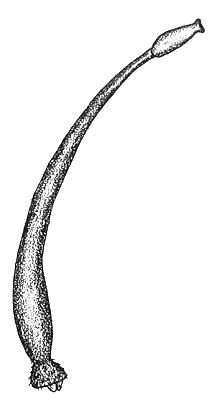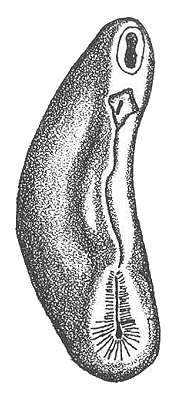

|
APLACOPHORA
|
|
(A-plac-o-phor-a,
from the Latin a=without plac=plate phor=carry:
i.e., not bearing a shell)
|
|
Chaetoderma
|
Neomenia
|
 |
 |
|
The Aplacophora are a small group of molluscs, which have deviated from the normal molluscan form. There are approximately 100 known species living today. They are rather worm-like and average about an inch (2.5 cms.) in length. Most live in deep water, except a few more northern species. One group bury themselves into the sand and mud of the ocean bottom where they feed on annelids and other small invertebrates. The rest of the known aplacophorans parasitize hydroids and other corals.
|
|||||
|
|||||
|
Characteristics
|
|||||
|
(Diagram)
|
|||||
|
|||||
|
The
shell is absent and there is no fossil record to suggest that any members
of the class ever had one.
The
fleshy mantle does not produce
a shell in aplacophorans but is embedded with calcareous
spicules, presumably to make them less palatable to predators. Their
body shape is slightly oval and flat in appearance; however, in one group
of aplacophorans, the order Chaetodermomorpha, the mantle has fused to
form a cylindrical body (note: we have Chaetoderms in Nova Scotia - in
St. Margaret's Bay (-Ross)!)
Aplacophorans only possess a trace of a mantle cavity. Gills are lacking in many of the species while others possess only secondary gills. The cloaca, a cavity into which the anus and a pair of nephridiopores empty, is possibly a remnant of the mantle cavity. |
|||||
|
|||||
|
The foot is either virtually absent or vestigial: a simple ventral fold: It is much reduced and has become just a tiny median ventral ridge lying in a small longitudinal groove. This means that the Aplacophora have no viable means of locomotion. |
|||||
|
|||||
|
In the aplacophorans this consists of a simple cerebral ganglion and a lateral nerve cord. There are no specialized sense organs such as eyespots or electrical or chemical sensors. |
|||||
|
|||||
|
The head is poorly defined in all aplacophora, and their visceral mass consists of a very simple and straight digestive system. Food taken in passes through the circumpharyngeal muscle into the oral cavity where a radula rasps it (the radula is usually present although it is often somewhat modified). The fine food particles then pass into a single midgut organ that consists of a stomach and digestive gland. A short intestine absorbs nutrients before the waste passes into the cloaca. |
|||||
|
|||||
|
Aplacophorans are either hermaphroditic (i.e., self-fertilizing, as in the family Proneomenia) or dioecious (i.e., having two separate sexes, as in the family Chaetoderma) (Two quite different sets of "family values"J). Copulation never occurs: males release sperm freely into the water. The females also release their eggs into the water, or hold them within their mantle cavity. In the latter case, inhalent water drawn into the female's mantle cavity contains sperm, which fertilizes the eggs held there. |
|||||